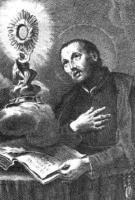
| 4 June |
• yesterday • tomorrow |

Petrock, Pedrog, Perreuse, Perreux, Petrocus, Petrox
Younger son of King Glywys. On his father's death, the people of Glywysing called for Petroc to take the crown of one the country's sub-divisions, but Petroc wanted a religious life, and went to study in Ireland.
Several years later he returned to Britain, landing on the River Camel in Cornwall. Directed by Saint Samson to the hermitage of Saint Wethnoc. Wethnoc agreed to give his cell to Petroc in order that he could found a monastery on the site.
After 30 years as abbot, Petroc made a pilgrimage to Rome, Italy. On his return, just as he reached Newton Saint Petroc, it began to rain. Petroc predicted it would soon stop, but it rained for three days. In penance for presuming to predict God's weather, Petroc returned to Rome, then to Jerusalem, then to India where he lived seven years on an island in the Indian Ocean.
Petroc returned to Britain with a wolf companion he had met in India. Founded churches at Saint Petrox and Llanbedrog. In Cornwall, with the help of Saint Wethnoc and Saint Samson, he defeated a mighty serpent that King Teudar of Penwith had used to devour his enemies. He then left his monastery at Llanwethinoc to live as a hermit in the woods at Nanceventon, some fellow monks following his example at Vallis Fontis. While in the wilderness, a hunted deer sought shelter in Saint Petroc's cell. Petroc protected it from the hunter, King Constantine of Dumnonia, and converted the king to Christianity in the bargain.
Petroc later moved deep into the Cornish countryside, encountering the hermit Saint Guron. Guron moved south allowing Petroc, with the backing of King Constantine, to establish a monastery called Bothmena (the Abode of Monks) at the site of the hermitage.
• c.594 at Treravel, Padstow, Cornwall (in modern England) of natural causes while on the road
• buried at Padstow
• relics stolen in 1177 and given to the Abbey of Saint Meen
• relics later returned to the Bothmena monastery
• relics destroyed during the English Reformation
• Bodmin, Cornwall
• Caernarfonshire, Wales
• Cornwall, England
• Devon, England
• Exeter, Devonshire, England
• Hollacombe, Devonshire, England
• Little Petherick, Cornwall
• Nansfenten, Cornwall
• Llanbedrog, Wales
• Lydford, Devonshire, England
• Newton Saint Petrock, Devonshire, England
• Padstow, Cornwall
• Saint-Méen, France
• South Brent, Devonshire, England
• Trevalga, Cornwall
• West Anstey, Devonshire, England
• bishop holding a church
• bishop with a stag
• bishop with a wolf
• coracle
• stag
• wolf
https://catholicsaints.info/saint-petroc/
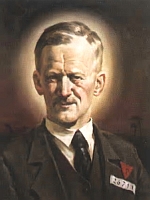
prisoner 26711
12 June as one of the 108 Martyrs of World War II
Graduated high school in 1914. Studied law at Jagiellonian University in Krakow, Poland, but his studies were interrupted by the start of World War I. Soldier and officer in the Austrian army, he fought on the eastern front and in Italy. Helped found the Polish army in 1918. Fought in the Polish-Ukrainian War of 1918-1919, defending the citadel of Lviv. Fought in the Polish-Russian war of 1920, rising to the rank of captain and receiving decorations for bravery. A near fatal bout of dysentery ended his military career in 1920.
Returning to civilian life with exceptional organization and people skills, he studied agriculture, and in 1921 took over management of the 1,000 acre Zamosc farms in Labunie, Poland; he was known for insuring his people were paid fairly, and had medical coverage. Married to Maria Theresa Szeptycka in 1921. The family went to daily Mass, and spent largely on charity, food for the poor, and Catholic social activities. Not content with checkbook-charity, he visited and helped the poor and orphans regardless of nationality or religion. He supported the Marian Congregation, Catholic Action, pilgrimages to Jasna Gora, and the study of Catholic social doctrine. Worked to create better working conditions and cooperation between farms to promote agricultural production. Vice-president of Catholic Action in 1932; president of the Diocesan Institute of Catholic Action in Lublin, Poland in 1935. He declined an offer to run for the Polish senate in 1935. Honorary papal chamberlain to Pope Pius XI.
Arrested with his brother Marian by invading Russian troops in November 1939; they escaped in Debiny Laszczowskiej, but Marian was re-captured, sent to the Russian interior, and was never heard from again. Stanislaw was captured by German troops and sent to the Nazi concentration camp at Dachau, Germany for the crime of being a Catholic leader. Martyr.
11 May 1895 in Ustrobna, Podkarpackie, Poland
13 April 1941 in Dachau, Oberbayern, Germany
13 June 1999 by Pope John Paul II
Catholic Action in Poland
He was an apostle in the camp. - Father Dominik Maj
I have no doubts that he was a hero and a saint. - Cardinal Adam Kozlowiecki
https://catholicsaints.info/blessed-stanislaw-kostka-starowieyski/
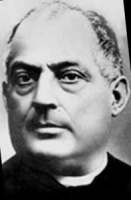
While in seminary, Filippo worked extensively with deaf-mutes in Naples, Italy. Ordained in 1871. While working with plague victims, he contracted the disease himself, but was miraculously cured through the intervention of Our Lady of Pompei. At one point, depressed over the frustration of his mute students, he asked to give up his teaching, and to work in the foreign missions; his spiritual advisor convinced him to stay, and Filippo threw himself into the work. In March 1885, with the help of Father Lorenzo Apicelia and several nuns he had trained, he founded a school for deaf-mutes in Lecce, Italy; it became the mother-house of the Congregation of the Salesian Sisters of the Sacred Hearts. Father Filippo soon expanded the work of his schools to include blind, orphaned, or abandoned children. Served as confessor and spiritual director to priests, seminarians, and several religious communities. Founded the Eucharistic League of Priest Adorers and Eucharistic League of Women Adorers. Superior of the Congregation of the Missionaries of Saint Francis de Sales. Canon of the Lecce cathedral. Recognized and commended by civil authorities for his good works.
27 July 1848 in Naples, Italy
4 June 1923 in Lecce, Italy from a combination of diabetes and a heart condition
15 October 2006 by Pope Benedict XVI
Saint Filippo Smaldone, son of South Italy, knew how to instill in his life the higher virtues characteristic of his land. A priest with a great heart nourished continuously on prayer and Eucharistic adoration, he was above all a witness and servant of charity, which he manifested in an eminent way through service to the poor, in particular to deaf-mutes, to whom he dedicated himself entirely. The work that he began developed thanks to the Congregation of the Salesian Sisters of the Sacred Hearts founded by him and which spread to various parts of Italy and the world. Saint Filippo Smaldone saw the image of God reflected in deaf-mutes, and he used to repeat that, just as we prostrate before the Blessed Sacrament, so we should kneel before a deaf-mute. From his example we welcome the invitation to consider the ever indivisible love for the Eucharist and love for one's neighbor. But the true capacity to love the brethren can come only from meeting with the Lord in the Sacrament of the Eucharist. - Pope Benedict XVI, from the canonization homily of Saint Filippo
https://catholicsaints.info/saint-filippo-smaldone/

• Ascanio Pisquizio
• Francesco Caracciolo
Born to the nobility; related to Saint Thomas Aquinas and to the princes of Naples. Enjoyed hunting. Cured of a leprous-like disease at age 22, he took the cure as a miraculous sign for his life. He sold his goods, gave the money to the poor, and went to study theology in Naples, Italy in 1585. Ordained in 1587. Joined the Contraternity of the Bianchi della Giustizia (the White Robes of Justice) whose ministry was with condemned prisoners. With John Augustine Adorno, he founded the Congregation of the Minor Clerks Regular with a ministry to the sick and to prisoners; they received approval from Pope Sixtus V on 1 July 1588, Pope Gregory XIV on 18 February 1591, and Pope Clement VIII on 1 June 1592. Chosen superior of the Congregation at Naples on 9 March 1593; he made sure to daily perform the most menial tasks of the house. Established Congregation houses in Rome, Madrid, Valladolid, and Alcala. Noted for his work for the poor, and as a miracle worker and prophet; he was a popular preacher, and cured by blessing the sick with the sign of the cross. Pope Paul V wished to make him a bishop, but he repeatedly refused, citing the Congregation's vow not to seek any high position in the Church. Near the end of his life he resigned his duties and spent his remaining time as prayerful prior and novice master at Santa Maria Maggiore.
13 October 1563 at his family's castle at Villa Santa Maria, Abruzzi, Italy as Ascanio Pisquizio
• 4 June 1608 at Agnone, Italy of a fever
• relics at Naples, Italy and San Lorenzo in Lucina, Rome, Italy
4 June 1769 by Pope Clement XIV
24 May 1807 by Pope Pius VII
• Association of Italian Cooks (chosen in 1996)
• Naples, Italy (chosen in 1838)
To heaven! - Saint Francis' dying words
https://catholicsaints.info/saint-francis-caracciolo/
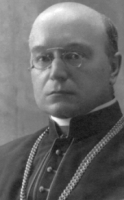
12 June as one of the 108 Martyrs of World War II
After high school, Antoni studied at the Metropolitan Seminary in Lublin, Poland, and the Theological Academy in Saint Petersburg, Russia. Ordained a priest for the archdiocese of Lublin in 1906. Father Antoni returned to Lublin where he served as vicar of the cathedral parish, professor of theology at the Lublin seminary, and vice-rector of the school from 1918 to 1929. Away from the school and church, he was active in local charities and became known in the city as the almoner for the money he raised for the poor.
On 17 November 1939, about 10 weeks into the German invasion of Poland, Father Antoni, along with other clergy in the diocese, was arrested by the Gestapo and imprisoned in Lublin Castle. On trumped up charges, stemming from being a loyal and active priest, Antoni was first sentenced to death, which was then commuted to life imprisonment. On 4 December 1939 he was transferred to the Sachsenhausen concentration camp, and then on 14 December 1940 he was transferred to the Dachau concentration camp. Over his remaining 18 months, between forced labour and torture sessions, Father Antoni ministered to other prisoners. Martyr.
10 November 1882 in Strumiany, Wielkopolskie, Poland
• 4 June 1942 in the Dachau concentration camp, Oberbayern, Germany of overwork, abuse and neglect
• his body was destroyed in the camp crematorium
13 June 1999 by Pope John Paul II
Metropolitan Seminary in Lublin, Poland
We are here for the faith, the Church and the Homeland; for this cause we consciously give our lives. - Blessed Antoni to fellow prisoners in Dachau
https://catholicsaints.info/blessed-antoni-zawistowski/
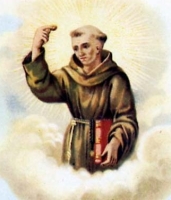
• Pacifico Ramati
• Pacificus of Ceredano
• Pacificus Ramota
Pacificus was orphaned very young. Educated at the Benedictine monastery in Novara, Italy. Joined the Friars Minor in 1445. Received a doctorate from the Sorbonne in Paris, France, and was considered one of the most learned men of his day. Ordained in 1452. Preached missions throughout Italy from 1452 through 1471. Sent by Pope Sixtus IV to Sardinia as an evangelist and reformer. Founded a monastery in Vigevano, Italy and used it as a base for his teaching and preaching. In 1480 he was sent to Sardinia to preach the Franciscan Crusade to Turkey.
c.1424 at Cerano, Novara, Lombardy, Italy
• 14 June 1482 in Sassari, Sardinia, Italy of natural causes
• relics at Cerano, Italy
7 July 1745 by Pope Benedict XIV (cultus confirmed)
Cerano, Italy
Summa Pacifica, a treatise on moral theology and the proper method of hearing confessions
https://catholicsaints.info/saint-pacificus-of-cerano/
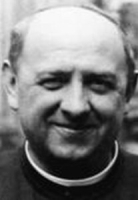
• Francis Pianzola
• Apostle of Lomellina
Born to a farming family. Studied at the seminary of Vigevano, Italy, and was ordained on 16 March 1907. He became an itinerant preacher, ministering to the poor, to children at their homes, to farm workers in the fields, to young women in the factories. Founded the Suore Missionarie dell'Immacolata, Regina della Pace (Missionary Sisters of the Immaculate, Queen of Peace) based in Mortara, Italy; the Sisters continued the work of taking Christ to the poor, the humble, the workers.
5 October 1881 in Sartirana Lomellina, Pavia, Italy
• 4 June 1943 at the General House of the Sisters in Mortara, Pavia, Italy of natural causes
• interred at the General House of the Sisters
• 4 October 2008 by Pope Benedict XVI
• beatification recognition celebrated at the cathedral in Vigevano, Italy by Cardinal Jose Saraiva Martins
https://catholicsaints.info/blessed-francesco-pianzola/
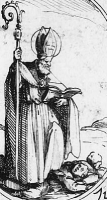
Optate, Ottato
Raised a pagan. Rhetorician. Convert to Christianity. Lived through the persecutions of Diocletian and Julian the Apostate. Late fourth century bishop of Milevis, Numidia (modern Algeria). Wrote against the Donatists.
interred in the cemetery of Saint Callistus, Rome, Italy
bishop trampling on heretics
You cannot deny that you know that in the city of Rome upon Peter first the chair of the bishop was conferred, in which sat the head of all the Apostles, Peter, whence also he was called Cephas, in which one chair unity should be preserved by all, lest the other Apostles should each stand up for his own chair, so that now he should be a schismatic and a sinner who should against this one chair set up another. - Saint Optatus
https://catholicsaints.info/saint-optatus-of-milevis/
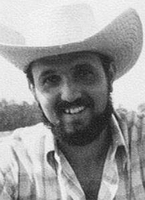
A member of the Missionaries of the Sacred Heart, making his profession on 8 September 1969. Ordained a priest in Valladolid, Spain on 9 June 1972. In 1975 he was sent to minister in Guatemala where he worked with the poorest people until murdered by the military. Martyr.
27 April 1945 in Barcelona, Spain
shot on 4 June 1980 in Xeixojbitz, Quiché, Guatemala
• 23 April 2021 by Pope Francis
• beatification recognition celebrated in Santa Cruz del Quiché, Guatemala
https://catholicsaints.info/blessed-jose-maria-gran-cirera/
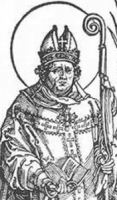
• Quirinus of Siscia
• Kvirin, Quirino
Bishop of Sescia (modern Sisak), Croatia. During the persecution of Galerius, he was ordered to sacrifice to pagan gods; he declined. Imprisoned, severely beaten, and martyred. While in prison he converted his jailer, Marcellus.
drowned in the River Raab with a millstone around his neck c.308
• against evil spirits
• obsession
• possessed people
• Sisak, Croatia
https://catholicsaints.info/saint-quirinus-of-sescia/
Francesco
Member of the Holy Spirit Community of Maiella (Celestines). Spiritual student of Saint Peter Celestine. Priest. Assisted Saint Peter at the hermitages of Orfente and Morrone. Prior of the Celestine monastery of the Holy Spirit in Maiella, Italy in 1285. First general of the Celestines, a post he held until his death. Created cardinal–priest of San Lorenzo in Damaso by Pope Celestine V on 18 September 1294.
1223 in Abri, Italy
13 October 1294 in Sulmona, Italy of natural causes
https://catholicsaints.info/blessed-francis-ronci/
Married layman of the diocese of Quiché, Guatemala. Worked as a sacristan for Blessed José María Gran Cirera in the parish of San Gaspar di Chajul, and was murdered with him. Martyr.
26 January 1951 in Ilom, Quiché, Guatemala
shot on 4 June 1980 in Xeixojbitz, Quiché, Guatemala
• 23 April 2021 by Pope Francis
• beatification recognition celebrated in Santa Cruz del Quiché, Guatemala
https://catholicsaints.info/blessed-domingo-del-barrio-batz/

Son of Dometius, a convert, priest and bishop of Constantinople around the fourth century; nephew of Emperor Probus. Bishop of Constantinople following his father and older brother in the position. Metrophanes' reputation for profound holiness and virtue is believed to have convinced Emperor Constantine the Great to make Constantinople the capital of the Empire.
325 of natural causes
https://catholicsaints.info/saint-metrophanes-of-byzantium/
Burian, Buryan
Sixth-century anchoress in Cornwall. The town of Saint Buryan, whose parish church served as her base, is named after her. May have been the daughter of an Irish king, and some writers says she travelled to Cornwall as a missionary to Cornish. One legend tells how she cured the paralysed son of King Geraint of Dumnonia, a miracle that brought many locals to the faith.
Ireland
https://catholicsaints.info/saint-buriana-of-cornwall/
Margarita, Margherita, Marguerite
Daughter of Duke Henry II of Brabant. Cistercian nun. Abbess at Vau-le-Duc, Brabant (in modern Belgium), an abbey founded by her father.
1277 of natural causes
considered beata by her order from the time of her death
https://catholicsaints.info/blessed-margaret-of-vau-le-duc/
Cornelius Mac Conchailleadh
Joined the Augustinians at Armagh, Ireland in 1140. Abbot in 1151. Archbishop of Armagh in 1174. Pilgrim to Rome, Italy; died on his way home.
Ireland
1176 in Canbery, Savoy, France of natural causes
https://catholicsaints.info/saint-cornelius-mcconchailleach/
Adalgrim, Adalgrin, Adegrin, Aldegrim
After a life as a knight, Aldegrin felt a call to religious life, and became a Benedictine monk at Baume Abbey. Spiritual student of Saint Odo of Cluny. Spent his latter years of his life as a hermit near Baume.
939 of natural causes
https://catholicsaints.info/saint-aldegrin-of-baume/
Benedictine monk and then abbot of the monastery at Fontenelle, France, a noted spiritual center. Recognized by Pope Innocent II for this holiness and zeal to spread the Faith.
England
1150 of natural causes
https://catholicsaints.info/saint-walter-of-fontenelle/
Benedictine hermit. Abbot. Founded the monastery of Serviliano in the Marches of Ancona, Italy, and served as its first abbot. The house became a leader in the resurgence of the Faith during that period.
1250 of natural causes
https://catholicsaints.info/saint-walter-of-serviliano/
Gwengustle, Nennoca, Nennocha, Nenoc, Nenooc, Ninnoc, Ninnocha
Daughter of Saint Brychan of Brycheiniog. Nun who followed Saint Germanus of Auxerre to France. Abbess of one or more convents in Brittany.
Britain
c.467 of natural causes
https://catholicsaints.info/saint-nennoc/
Branca, Banka, Breague
Spiritual student of Saint Brigid of Ireland. Missionary to Cornwall, England c.460. Worked with Saint Crewanna and Saint Elwin.
5th-century in East Meath, Ireland
https://catholicsaints.info/saint-breaca-of-cornwall/
Cirino
One of a group of approximately 200 Christians martyred together. His is the only name that has come down to us, and we have no further details about him.
Aquileia, Italy
https://catholicsaints.info/saint-cyrinus-of-aquileia/
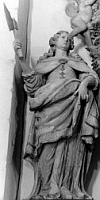
Saturnine
Virgin-martyr.
German
near Arras, France, date unknown
https://catholicsaints.info/saint-saturnina-of-arras/
Edfrid, Eadfrith
Bishop of Lindisfarne, England. He illuminated the Lindisfarne Gospels in honour of Saint Cuthbert.
721
https://catholicsaints.info/saint-edfrith-of-lindisfarne/
Ernineus
Son of Craskin. Though he is mentioned in several martyrologies, menologies and writings, no details about him have survived.
634
https://catholicsaints.info/saint-ernin-of-cluain/
Alonium, Halonium
Hermit in the Egyptian desert noted by other monks, abbots and hermits for his wisdom and clear thinking.
late 4th century
5th century
https://catholicsaints.info/saint-alonio/
Arecius, Aregius
Martyr.
• Rome, Italy, date unknown
• buried in the catacombs on the Appian Way
https://catholicsaints.info/saint-aretius-of-rome/
One of a group of martyrs, and the only one whose name has come down to us.
martyred in Sabaria, Pannonia (in modern Hungary)
https://catholicsaints.info/saint-rutilus-of-sabaria/
Mercedarian nun at the monastery of Santa Maria della Pieta in Marquina, Spain for 80 years. Had the gift of healing by prayer, and of inedia.
https://catholicsaints.info/blessed-menda-isategui/
Cistercian monk. Prior of the abbey in Villers, Belgium.
c.1280 of natural causes
https://catholicsaints.info/blessed-boniface-of-villers/
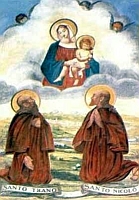
Hermit.
https://catholicsaints.info/saint-nicolo-of-sardinia/
Martyr.
• Rome, Italy, date unknown
• buried in the catacombs on the Appian Way
https://catholicsaints.info/saint-dacian-of-rome/

Hermit.
https://catholicsaints.info/saint-trano-of-sardinia/
Martyr. No reliable information has survived.
Tivoli, Italy, date unknown
https://catholicsaints.info/saint-quirinus-of-tivoli/
Bishop of Brescia, Italy. Martyred in the persecutions of Nero.
64
https://catholicsaints.info/saint-clateus-of-brescia/
Monk at Saint-Savin, Lavedan, France.
c.1050 of natural causes
https://catholicsaints.info/saint-elsiar-of-lavedan/
Martyr.
Sicily, Italy, date unknown
https://catholicsaints.info/saint-christa-of-sicily/
Eighth century bishop of Verona, Italy.
https://catholicsaints.info/saint-alexander-of-verona/
Dagan
Sixth century spiritual student of Saint Petroc in Cornwall.
https://catholicsaints.info/saint-degan/
Sixth century spiritual student of Saint Petroc in Cornwall.
https://catholicsaints.info/saint-croidan/
Sixth century spiritual student of Saint Petroc in Cornwall.
https://catholicsaints.info/saint-medan/
A group of 13 Christians who were martyred together. The only details about them that have survived are their names –
• Cama
• Christa
• Crescentia
• Eiagonus
• Expergentus
• Fortunus
• Italius
• Jucundian
• Julia
• Momna
• Philip
• Rustulus
• Saturnin
in Cilicia, Asia Minor (in modern Turkey), date unknown
https://catholicsaints.info/martyrs-of-cilicia-4-june/
A group of 41 Christians martyred together for refusing to sacrifice to imperial Roman idols. We know the names of some, but no other details.
• Amatus
• Attalus
• Camasus
• Cirinus
• Dinocus
• Ebustus
• Euticus
• Eutychius
• Fortunius
• Galdunus
• Julia
• Quirinus
• Rusticus
• Saturnina
• Saturninus
• Silvius
• Uinnita
• Zoticus
beheaded in Noviodunum (modern Nyon, Switzerland)
https://catholicsaints.info/martyrs-of-nyon-4-june/
• Mary the Planter
CatholicSaints.Info Portable Edition